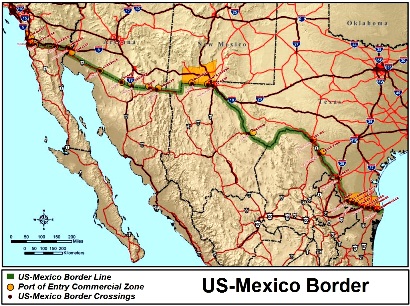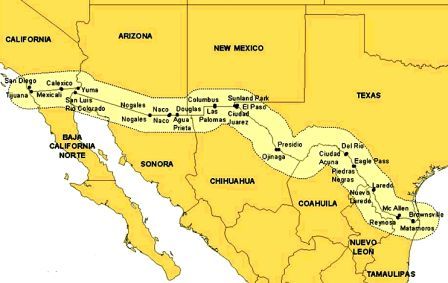|

Map of the US Mexican Border
|
US Mexican Border History Facts: Fast Fact Sheet
Fast, fun facts and Frequently Asked Questions (FAQ's)
about the US Mexican Border
for kids.
How
long is
the US Mexican Border? The US Mexican Border
is 1,989 miles (3,145 km) long, spanning six
Mexican states and four U.S. states and
stretches from the Gulf of Mexico to the
Pacific Ocean.
What are the US states along the Mexican Border? The
US states along the Mexican Border are
California, Arizona, New Mexico, and Texas.
What are the Mexican Border states?
The Mexican Border states are Baja
California, Sonora, Chihuahua, Coahuila,
Nuevo León, and Tamaulipas
When was the
US Mexican Border established?:
The US Mexican Border was established by the
1848
Treaty of Guadalupe Hidalgo.
US
Mexican Border
History Facts for kids
The following fact
sheet contains interesting facts and information on US Mexican Border
for kids.
Facts
about the US Mexican Border for kids
US Mexican
History Fact 1: The US Mexican Border was partially
established in 1848 by the
Treaty of Guadalupe Hidalgo
that specified that the middle of Rio Grande was the
border.
US Mexican
History Fact
2: The
1853 Gadsden Purchase
agreed the current boundary line when the US paid
$10 million dollars to extend
the southern boundary of New Mexico and Arizona
southwards to enable the United States to construct
the southern
transcontinental railroad.
US Mexican
History Fact 3: The International Boundary and Water Commission (IBWC)
was created in 1889 by the United States and Mexico to administer
the boundary and water rights agreements between the two countries.
US Mexican
History Fact 4: In 1902 the Newlands Reclamation Act
funded irrigation projects for the arid lands of 20
states in the American West. Large factory farms
sprang up replacing traditional family farms and Mexico
provided the greatest source of agricultural labor.
Growers increased their profits by employing illegal
Mexican labor from across the border.
US Mexican
History Fact 5: In
1904 Mounted Guards of the U.S. Immigration Service, operating out
of El Paso, Texas, began patrolling the US Mexican border in
an effort to prevent illegal crossings.
US Mexican
History Fact 6: In 1910 the
Mexican
Revolution began
and thousands of Mexicans fled across the US border for
safety
US Mexican
History Fact 7: In
1915 United
States Congress authorized
"Mounted Inspectors" along
the US Mexico Border who
operated by horseback, automobiles and on boats..
US Mexican
History Fact 8: The United
States declared war on Germany
on
April 6, 1917 and entered
into WW1. Intercepting communications to "the enemy" was of
greater concern to the government than enforcing immigration
regulations.
US Mexican
History Fact 9: WW1 created a labor shortage as
Americans joined the Allies in Europe and Mexicans were
encouraged to work in the USA.
US Mexican
History Fact 10:
The 18th Amendment, prohibiting the importation or sale
of liquor, went into effect on January 16, 1920 and the
Prohibition Era led to a massive increase in smuggling
across the Mexican border. However, regulations
involving customs were extremely difficult to enforce
and the bootleggers began smuggling an illegally
produced liquor called "Sotol".
US Mexican
History Fact 11:
The
Immigration Act of 1924 restricted
the number of immigrants
from a given country
and prompted even more people
to try to enter the United States illegally. The US Mexican Border
Patrol became critical to the U.S. Government who passed the 1924
Labor Appropriation Act.
US Mexican
History Fact 12:
The Labor Appropriation Act of 1924 established the
Border Patrol and Border Stations
to combat illegal
immigration and smuggling.
In 1925 the duties were expanded to patrol the seacoast as the
government increased their efforts to control the situation
Continued...
Facts
about the US Mexican Border for kids
Facts
about the US Mexican Border for kids
The following fact
sheet continues with facts about US Mexican Border for kids.
Facts
about US Mexican Border for kids
US Mexican
Border History Fact 13:
The federal government viewed border security and border
protection as a major issue in their attempts to restrict and
control immigration into the United States and the Border Patrol
expanded to 450 officers.
US Mexican
Border History Fact 14: The government initially provided the
Border agents with a revolver and a badge. The Border
Patrol began wearing uniforms in 1928.
US Mexican
Border History Fact 15: The first Border Patrol Academy
opened in 1934 at Camp Chigas, El Paso. By 1940 there
were 1400 agents.
US Mexican
Border History Fact 16: During World War 2 (1939 - 1945), the
Patrol provided tighter control of the border and
assisted the U.S. Coast Guard in searching for Axis
saboteurs. The Bracero
Program (1943 - 1965) was
established bringing 5 million temporary Mexican
Laborers to work in US farms
and on the railroads across
a twenty-two year period
to help the US economy during,
and after, World War Two.
US Mexican
Border History Fact 17: The Immigration and Nationality Act
of 1952 expanded the Border Control to include the
search of vehicles anywhere in the United States, not
just at the point of entry, and illegal immigrants were
subject to arrest.
US Mexican
Border History Fact 18: In 1953 "Operation
Wetback" was launched as a system of cooperation
between the U.S. Border Patrol
and the Mexican government to
control illegal immigration.
During Operation
Wetback the U.S.
Immigration Service deported
more than 3.8 million people
of Mexican descent.
US Mexican
Border History Fact 19: In the late 1950's private airplanes
were used to carry illegal immigrants from Mexico to
America and agents began working with airline industry
to combat the trend..
US Mexican
Border History Fact 20: In the early 1960's drug smuggling
started to become a significant issue and the Border
Patrol began assisting other federal agencies to
intercept drugs from Mexico.
US Mexican
Border History Fact
21: In 1964 the first maquiladora factories were established
under the Border Industrialization
Program
US Mexican
Border History Fact
22: In the 1980's and 1990's the number
of illegal immigrants sky-rocketed. The Border Patrol
extended their manpower and began to use modern
technology to combat the problem.
US Mexican
Border History Fact
23: The Patrol made good use of computer
technology and began to use seismic sensors and infrared
technology to assist them in border security and
protection.
US Mexican
Border History Fact
24: In 1993 the Immigration and
Naturalization Service (INS) initiated the "Operation
Hold the Line" as a preventative measure against illegal
immigration taken by the United States Border Patrol.
"Operation Hold the Line" was initially called
"Operation Blockade" and involved a a human and vehicle
blockade along the border. There were 400 agents and
vehicles every 100 yards from one side of El Paso to the
other.
US Mexican
Border History Fact
25: Following the success of "Operation
Hold the Line" a new initiative was launched in 1994
called "Operation Gatekeeper" which was located in the
San Diego sector.
US Mexican
Border History Fact
26: The Terror Threat: The
9/11 terrorist attacks exposed weaknesses in America's Border systems
and Homeland Security became a primary concern. On March
1, 2003 the Department of Homeland Security (DHS) was
established, and the US Border Patrol became part of US
Customs and Border Protection (CPB).
US Mexican
Border History Fact
27: The Terror Threat: In 2006
the Secure Fence Act authorized
fencing along the US-Mexican
Border and authorized the use
of surveillance technology.
US Mexican
Border History Fact
28: The American states along the Mexican
Border are California, Arizona, New Mexico, and Texas.
US Mexican
Border History Fact
29:
The Mexican states along the border are Baja
California, Sonora, Chihuahua, Coahuila, Nuevo León, and
Tamaulipas
US Mexican
Border History Fact 30: There are currently 45 US Mexico
border crossings with 330 ports of entry.

US Mexican
Border History Fact 31: California Border Crossings:
● San Diego – Tijuana, Baja
California
● Otay Mesa – Tijuana, Baja
California
● Tecate – Tecate, Baja
California
● Calexico – Mexicali,
Baja California
● Andrade – Los Algodones,
Baja California
US Mexican
Border History Fact 32: Arizona Crossings:
● San Luis – San Luis Río
Colorado, Sonora
● Lukeville – Sonoyta, Sonora
● Sasabe – Altar, Sonora
● Nogales – Nogales, Sonora
● Naco – Naco, Sonora
● Douglas – Agua Prieta, Sonora
US Mexican
Border History Fact 33: New Mexico Crossings:
● Antelope Wells – El Berrendo,
Chihuahua
Columbus – Palomas, Chihuahua
Santa Teresa – San Jerónimo, Chihuahua
US Mexican
Border History Fact 34: Texas Crossings:
● El Paso – Ciudad Juárez,
Chihuahua
● Fabens – Práxedis G.
Guerrero, Chihuahua
● Fort Hancock – El Porvenir,
Chihuahua
● Presidio – Ojinaga, Chihuahua
● Heath Canyon – La Linda,
Coahuila (closed)
● Del Rio – Ciudad Acuña,
Coahuila
● Eagle Pass – Piedras Negras,
Coahuila
● Laredo – Nuevo Laredo,
Tamaulipas
● Laredo – Colombia, Nuevo León
● Falcon Heights – Presa Falcón,
Tamaulipas
● Roma – Ciudad Miguel Alemán,
Tamaulipas
● Rio Grande City – Ciudad
Camargo, Tamaulipas
● Los Ebanos – Gustavo Diaz
Ordaz, Tamaulipas
● Mission – Reynosa, Tamaulipas
● Hidalgo – Reynosa, Tamaulipas
● Pharr – Reynosa, Tamaulipas
● Donna – Rio Bravo, Tamaulipas
● Progreso – Nuevo Progreso,
Tamaulipas
● Los Indios – Matamoros,
Tamaulipas
● Brownsville – Matamoros,
Tamaulipas
Facts
about US Mexican Border for kids
Facts
about
US Mexican Border
for kids
For visitors interested in the history of
US Immigration refer to the following articles:
US Mexican Border - President Calvin Coolidge Video
The article on the US Mexican Border provides detailed facts and a summary of one of the important events during his presidential term in office. The following
Calvin Coolidge video will
give you additional important facts and dates about the political events experienced by the 30th American President whose presidency spanned from August 2, 1923 to March 4, 1929.
US Mexican Border
●
Interesting Facts about US Mexican Border for kids and schools
●
Summary of the US Mexican Border in US history
●
US Mexican Border of important, key
events
●
Calvin Coolidge Presidency from August 2, 1923 to March 4, 1929
●
Fast, fun facts about the US Mexican Border
●
Foreign & Domestic
policies of President Calvin Coolidge
●
Calvin Coolidge Presidency and
US Mexican Border for schools,
homework, kids and children |